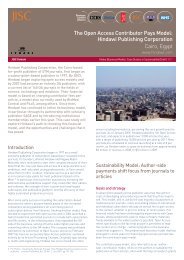A Concise Guide to Researching Audiences - Strategic Content ...
A Concise Guide to Researching Audiences - Strategic Content ...
A Concise Guide to Researching Audiences - Strategic Content ...
Create successful ePaper yourself
Turn your PDF publications into a flip-book with our unique Google optimized e-Paper software.
5. Modelling the audienceThis chapter deals with analysis and interpretation of audience data <strong>to</strong> address specific objectives andimprove understanding of the audienceData from an audience analysis project should improve understanding of the audience in several ways:• Answers <strong>to</strong> specific research questions – or further evidence• New knowledge about the audience and its interactions with the service• Objectives for future audience researchTopics covered in this chapter include approaches <strong>to</strong> analysing quantitative and qualitative data, potentialproblems with data interpretation and developing personas or user profiles for service development.5.1 Introduction5.1.1 This section deals with the issues involved in analysing and interpreting the data <strong>to</strong> address the specificresearch questions and build a better understanding of the audience and its interactions with the service.5.1.2 The audience data must be analysed appropriately: the techniques used will depend on the type of data andthe aims of the research. The data should provide evidence that can be interpreted <strong>to</strong> draw conclusionsrelevant <strong>to</strong> the specific objectives of the research. It is important <strong>to</strong> be sure that the data really do provideevidence for any statements you make and that you have considered all the possible interpretations of thedata. Full analysis and interpretation of the data should also provide wider insights in<strong>to</strong> the audience, andits behaviour and relationship with the service.Case study extract… JISC national e-books observa<strong>to</strong>ry projectA good example of analysing research data <strong>to</strong> understand user behaviourThe JISC national e-books observa<strong>to</strong>ry project is a 2-year project led by JISC Collections, which isinvestigating user behaviours and the demand, usage, delivery and business models for course text e-books.The outputs of this research will support the future procurement of e-books in the sec<strong>to</strong>r.This project is using a number of complementary research methods including web analytics, user interviewsand surveys <strong>to</strong> understand how users interact with electronic books. For example, the project is using weblog data <strong>to</strong> provide quantitative measures of usage and suggest a number of possible interpretations ofuser behaviour. However, this data must be treated with care (eg does a low number of searches indicatethat a user has quickly found the resource they wanted, or that they have given up after one attempt?).More detailed analysis of usage data (ie web analytics) may be informative, but interviews and surveys arebeing conducted <strong>to</strong> help validate assumptions and inferences from the web log data, and <strong>to</strong> develop anunderstanding of user behaviour.For further information, please see the project website (www.jisc-collections.ac.uk/catalogue/jiscebooksproject).PAGE 225. Modelling the audience



